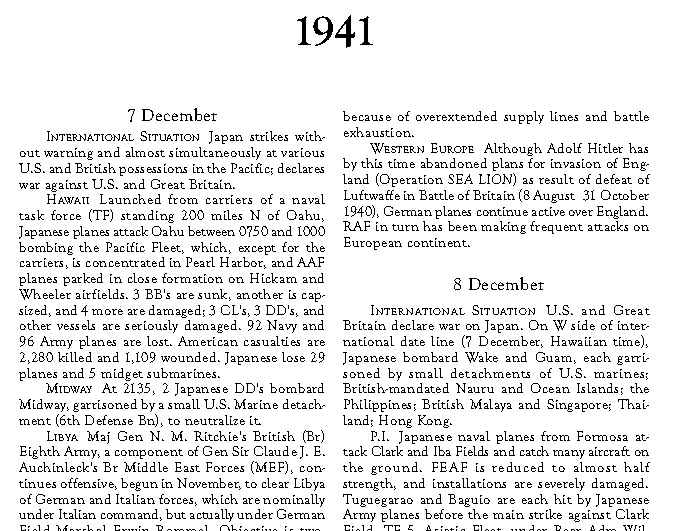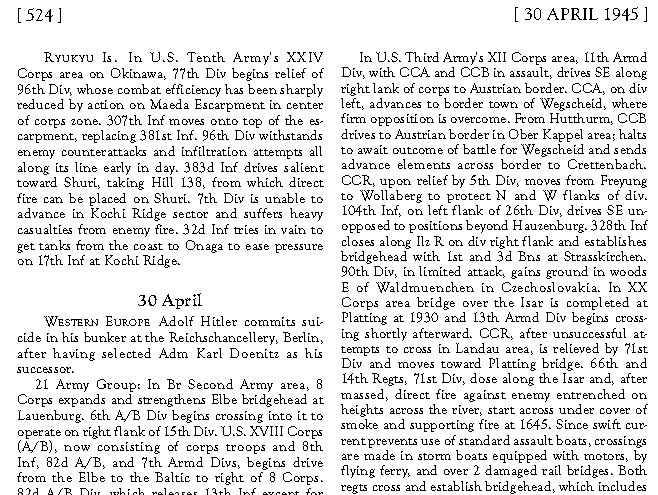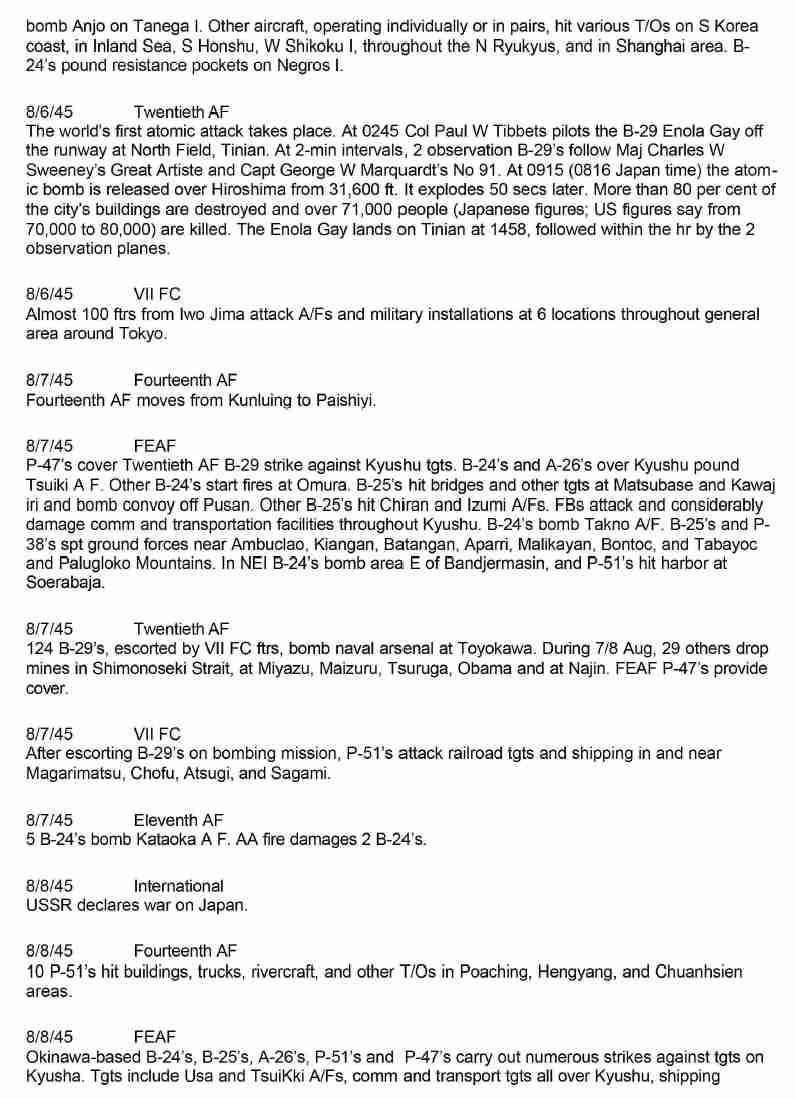|
World War II
U.S. Army and U.S. Air Force Chronologies
1,415 pages of United States Army and United States Air Force produced chronologies, providing day by day coverage of World War II.
Covers Army and Air Force events in Africa, Europe, the Middle East, Southeast Asia, the Far East, the Pacific, and the Western Hemisphere.
Each page of the volumes are graphically reproduced on the discs. The discs contain a text transcript of all text embedded into the graphic image of each page of each document, creating a searchable finding aid. Text searches can be done across all files on each disc.
United States Army Chronology: 1941-1945
This massive 672 page compilation establishes the sequence of events in World War II from the time the first bombs fell on Pearl Harbor on 7 December 1941 until the surrender of the Japanese aboard the USS Missouri in Tokyo Bay on 2 September 1945. The volume details the tactical events of the war day by day, thus giving the reader a measure of the scope of global coalition warfare so that he can begin to grasp the relationship of the innumerable parts to the whole.
This volume emphasizes the ground actions of the U.S. Army in its various operations in Africa, Europe, the Middle East, Southeast Asia, the Far East, the Pacific, and the Western Hemisphere. Events are related at the appropriate level, including battalion and lesser units as well as regiment, division, corps, army, and army group. In addition, the combat actions of Army, Air, Navy, and Marine Corps units and of British, French, Soviet, and other Allied armed forces, as well as those of the enemy, are given in as much detail as space limitations allow. General events of historical import also appear in their proper places.
The value of this well-indexed book is twofold. In one volume the general reader and the student of military history have a ready reference to the whole war during that period in which the United States participated and can quickly check individual facts and dates. In addition, they are able to observe at a glance the progress of the combat operations on a global level for any given day or follow the progress of a single unit day by day to the conclusion of a specific campaign.
Geographically, events for the period from Pearl Harbor to the invasion of Normandy on 6 June 1944 are arranged in sequence from the Western Hemisphere westward around the world. From D Day to the end of the war the order is reversed, the action in western Europe taking precedence. Thus, the attack on Pearl Harbor is dated 7 December while the events occurring simultaneously in the Far East appear under 8 December. An exception has been made for the Gilberts and Marshalls campaign because the scene of engagement lies so near the International Date Line and also because most of the records consulted are dated west longitude.
To itemize the materials used in the preparation of this work of reference would be tedious, if not impossible. Suffice it to say that the compiler consulted extensively After Action Reports, histories of units engaged, dispatches of the Allied commanders, and other primary sources, but for correctness and completeness relied heavily on the findings of the historians who have written and are writing other volumes for the United States Army.
United States Air Force Chronology
The U.S. Army in World War II: Chronology, 1941-1945, prepared by the U.S. Army's Office of the Chief of Military History.
This 743 page chronology is concerned primarily with operations of the US Army Air Forces and its combat units between December 7, 1941 and September 15, 1945. The research was a cooperative endeavor carried out in the United States Air Force historical archives by the Research Branch of the Albert F. Simpson Historical Research Center.
Such an effort has demanded certain changes in established historical methodology, as well as some arbitrary rules for presentation of the results. After International and US events, entries are arranged geographically. They begin with events at Army Air Forces Headquarters in Washington then proceed eastward around the world, using the location of the headquarters of the numbered air forces as the basis for placement. For this reason, entries concerning the Ninth Air Force while operating in the Middle East follow Twelfth Air Force. When that headquarters moves to England in October 1943, the entries are shifted to follow Eighth Air Force. The entries end with those numbered air forces which remained in the Zone of the Interior, as well as units originally activated in the Zone of the Interior, then designated for later movement overseas, such as Ninth and Tenth Air Forces. The Zone of the Interior entries do not include Eighth and Twentieth Air Forces, which were established in the Zone of the Interior with the original intent of placing them in those geographical locations with which they became historically identified. For these two units, original actions are shown either under AAF or in their intended geographic area of location.
All times and dates used are those of the area under discussion. The entry "1/2 Jun" indicates that an event occurred during the night between the two given dates, while "1-2 Jun" indicates an action over a period of time.
In dealing with people, again arbitrary decisions were implemented. For military men below the general officer or equivalent level, full grade and name were used. For general officers and those of equal grade in other US and foreign services, the complete rank (both that at the time first mentioned and the highest rank held prior to the end of the war) and name will be found in the index. Only an abbreviated rank (e.g., Gen or Adm) and last name are used in the text. The exception is where two general officers had the same last name; in such cases, the first name is also included. Similarly for civilian leaders, only the last name is used; full name and title are given in the index.
Location of all towns, islands, etc., is also made in the index. In all cases, attempts were made to cite place names in use by the native population at the time of or immediately before the war. No names imposed by a conqueror are used. For example Pylos Bay, not Navarino Bay, is used. Further, as appropriate, native geographic terms are used: Shima for island in. Japanese island groups, See for lake in Germany. However, two exceptions were made. In cases in which the place became infamous because of the actions of the conquering power, that name is preferred-for example Auschwitz would be used rather than the Polish name of Oswiecim. Also, in larger international cities, such as Roma, Koln and Wien, the anglicized name is used. Where a village or hamlet was difficult to locate or where there were several such places with the same name in a general area, the coordinates are given in the index. In some cases, with no extant navigational aids of the attacking force, the best possible guess was made based upon all available evidence. In other instances, such as the bridge at Hay-ti-attacked so often by Tenth Air Force-- a logical guess could not be made. In these cases, a question mark is placed in brackets after the index entry. Accent marks, such as umlauts, were omitted.
The disc contains a text transcript of all recognizable text embedded into the graphic image of each page of each document, creating a searchable finding aid. Text searches can be done across all files on the disc.
|
|


